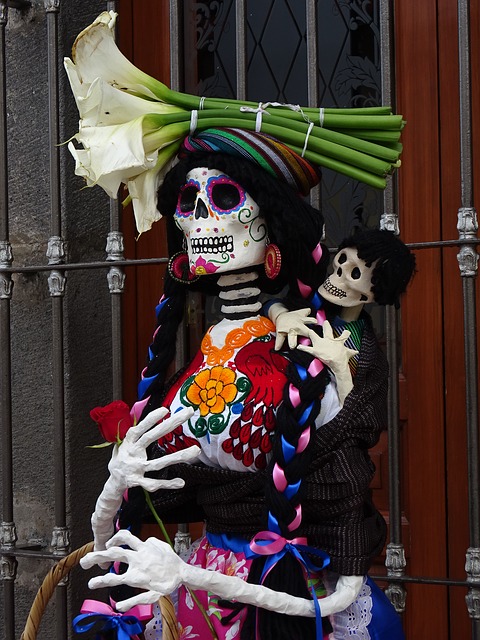Each year, between October 31 and November 2, the dead return to Mexico. They flood the streets in ornate, colorful clothing, bearing painted-skull faces and sugary treats. The Día de (los) Muertos, or Day of the Dead, is a Mexican tradition thousands of years in the making. While similar and related to Halloween, the holiday stems from a much different perspective. Read on to learn more about Día de Muertos, its origins, and how you can celebrate with your own family.
Origins of Día De Muertos
Allhallowtide and All Saints’ Day
Día de Muertos is an indigenous holiday that has gradually merged with the Catholic festival of Allhallowtide. This three-day period commemorates the departed faithful. October 31, or All Hallows’ Eve, marks a vigil held through the night to All Saints’ Day. In this case, saints can mean both the recognized Catholic saints as well as all those who made it into Heaven. All Souls’ Day, on November 2, is a time to pray for souls still lingering in Purgatory. According to Catholic belief, the prayers of the living can help those in Purgatory shed their sins and ascend to Heaven. .
The Link Between Halloween and Día de Muertos
Thanks in part to its close association with death, Allhallowtide has sometimes picked up older customs from other cultures. In the United States, for example, All Hallow’s Eve is more widely known as Halloween. The secular holiday grew popular through Scottish and Irish immigrants. It is likely a remnant of the Celtic-pagan festival Samhain. As the transition between summer and winter, Samhain brought the world of the living and the dead close together. Halloween thus came to represent mischief, mumming (or wearing costumes in public), hauntings, and harvests.
A similar process occurred in Mexico, this time drawing from the ancient holidays of Mesoamerica. Civilizations like the Maya and Mexica, or Aztecs, viewed death as a natural reflection of life. Departed spirits embarked on a long journey to the afterlife, and they sometimes needed guidance from the living to make it. For about a month of every year, Mesoamerican communities honored their dead and made offerings to assist them on their way. Elements of this practice blended with Allhallowtide to form the modern Día de Muertos.
And so, while Halloween focuses on the fearful aspects of spirits, the Day of the Dead sees them as the souls of beloved family members. Death, as a natural part of life, is something to be respected instead of avoided. And the visiting dead, far from being feared, are welcomed with love, food, and stories to help them on their way.
Celebrating the Day of the Dead
For centuries, Día de Muertos was primarily celebrated in Southern and Central Mexico. Over time, however, it has spread to become a national holiday. Today, it is widely recognized through iconic elements such as sugar skulls, colorful paper art, La Catrina, golden marigolds, candles lit for the dead, sweet breads, and mariachi music.
Mictecacihuatl, Santa Muerte and La Calavera Catrina
Perhaps the most important deity of death was the Aztec goddess Mictecacihuatl. As the Lady of Death, she ruled over the underworld with her husband, Mictlantecuhtli. She is thought to have survived in modern popular culture as Santa Muerte, a folk saint depicted as a skeletal woman in fine clothing.
In the early 20th century, the Mexican artist José Guadalupe Posada began using skeletal figures political cartoons. He sought to remind everyone that below our finery, we are all the same. One of his creations, La Calavera Catrina, resonated in particular. Famous artist Diego Rivera included her in one of his murals, and so she became a national symbol. Today, many women dress up as La Catrina, including face paint, or decorate their homes and businesses with her image.
Ofrendas and Sweets
At the heart of Día de Muertos sits the ofrenda, an altar created by each family to welcome their departed loved ones. These typically include photographs of the deceased, as well as offerings of their favorite foods and drinks. Marigolds, sugar skulls, incense, religious imagery, and candles are also common sights.
Besides sugar skull candies and sweet chocolate, one of the most popular foods of the holiday is pan dulce, or pan de muerto, the bread of the dead. Despite its somewhat macabre name, this bread is a favorite treat of the living and the dead alike. It is most distinctive for its rich orange- and anise-infused flavor. Pan de Muerto is often shaped into a distinctive bun or other figures.
Modern Celebrations
Today, Día de Muertos is celebrated all across Mexico as well as in parts of the United States. Every year in these areas, streets and homes come alive with the joyous depictions of the dead. More privately, families gather in cemeteries to remember their departed, share stories of their ancestors, and offer prayers.
Learn More About the Day of the Dead:
Top Image: An ofrenda with offerings for Día de Muertos, the Day of the Dead. Image by Ernesto Lau.
References
Brandes, Stanley. Skulls to the Living, Bread to the Dead: The Day of the Dead in Mexico and Beyond. John Wiley & Sons, 2009.
“Indigenous Festivity Dedicated to the Dead.” UNESCO, UNESCO, https://ich.unesco.org/en/RL/indigenous-festivity-dedicated-to-the-dead-00054.
Rollin, Tracey. Santa Muerte: The History, Rituals, and Magic of Our Lady of the Holy Death. Red Wheel/Weiser, 2017.
About TOTA
TOTA.world provides cultural information and sharing across the world to help you explore your Family’s Cultural History and create deep connections with the lives and cultures of your ancestors.




